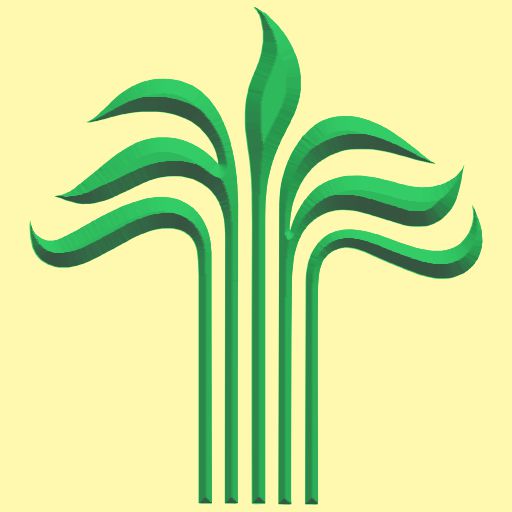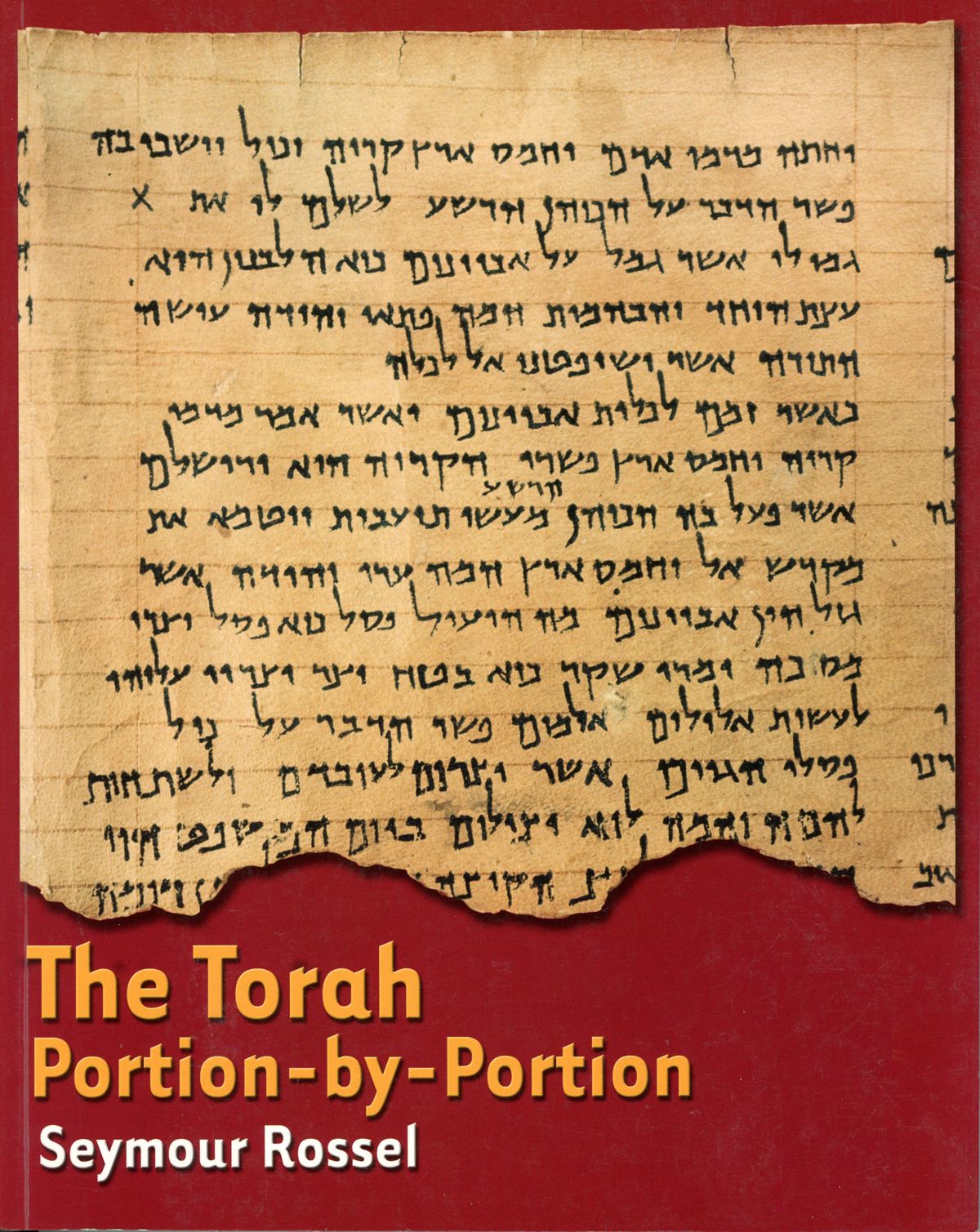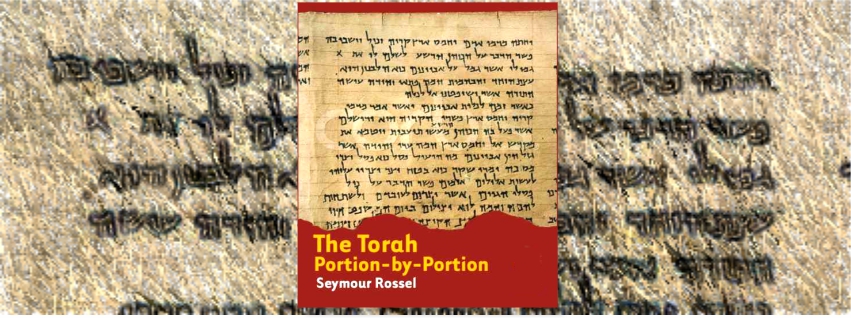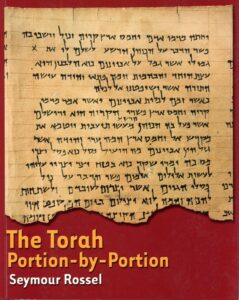The Torah: Portion-by-Portion
Paperback, 368 pages, $16.95
ISBN-10: 1891662945
ISBN-13: 978-1891662942
The Torah: Portion-by-Portion
Seymour Rossel
Studying Torah with a master teacher is like entering a world of intrigue and wisdom.
The Torah: Portion-by-Portion combines the fruits of 250 years of modern Bible study with the best of traditional Jewish commentary.
Each chapter, covering a single portion of the Torah as read in the synagogue, features a wealth of resources, including:
- selections of Torah text in gender-sensitive translation;
- “Quotes to Remember” in Hebrew and English;
- a synopsis of the traditional haftarah and the reason this particular prophetic reading was paired with its portion;
- interactive topical discussion questions;
- graphs, charts, maps, and photographs that illuminate archaeological finds and biblical criticism;
- wide-ranging comments from Talmud, Midrash, Rashi, and other traditional commentators—set side-by-side with comments from modern Bible scholars including Cassuto, Leibowitz, Peli, Bamberger, Plaut, and Friedman; and
- evidence from archaeology, linguistics, Egyptology, Assyriology, and a dozen other sciences that have been applied to the study of Torah in modern times.
With The Torah: Portion-by-Portion liberal Jews—Conservative, Reform, and Reconstructionist—have immediate access to interactive Torah study. The book can be read from cover to cover, or used as a resource in preparing talks about a particular Torah portion. As an introduction to Torah study, it bridges the gap between Bible stories and commentaries by scholars like Plaut, Sarna, and Tigay.
“Seymour Rossel’s The Torah: Portion-by-Portion will be hailed by educators the world over. We struggle with adult versions of the Torah portion for each week, adapting them as best we can ad hoc. No more! With the appearance of Rossel’s Chumash, teachers will be able to teach and discuss the sidra with authority. Particularly welcome is his inclusion of up-to-date information on archaeology and the documentary hypothesis, without which no new treatment of Torah can be considered complete. Col HaCavod!“
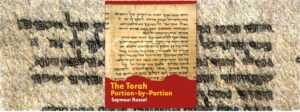
The Torah: Portion-by-Portion / “Q & A”
What is included in The Torah: Portion-by-Portion?
Each chapter covers a single weekly reading from the Torah and a description of the haftarah (prophetic reading) that usually accompanies that portion. In addition, all chapters contain ample quotations from the Torah text, a featured “Quote to Remember” in Hebrew (with English translation), a series of sidebars entitled “To Consider” giving openings for classroom or interactive discussion, other sidebars that contain additional information and often questions that can be used with classes or individuals, and photographs or drawings that illustrate important concepts and objects mentioned in the narrative. There are also maps and descriptive drawings to help the teacher clarify the locations mentioned in the narrative.
How do I decide what to teach since there are not enough days in the teaching calendar to cover all the chapters in a single year?
The Torah itself was never meant to be a “curriculum” in the modern sense. But the modern teacher obviously must confront this problem head on. There are several alternatives:
• It is generally possible to cover all the portions in a two or three year cycle (similar to the two- or three-year cycles in which the Torah was traditionally read in many communities), or…
• The curriculum can be designed to cover only those portions that fall within the school year, or…
• Depending on the reading skills of the students, more than one portion can be covered each week.
Can I use this commentary with my Bar/Bat Mitzvah students?
One of the primary uses of The Torah: Portion-by-Portion should be to help young people prepare divrei Torah (“words of Torah,” traditionally the basic element of a Bar/Bat Mitzvah speech). Sometimes, a student should be guided to read the chapter of the portion immediately before his or her own (and, at times, the chapter immediately following it) to get the overall “sense” of where the student’s portion “belongs” in the logic of the Torah. In preparing with Bar/Bat Mitzvah students, parents should be encouraged to read and discuss the portion with their child — this is possible since the questions and the sidebars provide ample guidance for the parents. Rabbis and teachers helping to prepare the Bar/Bat Mitzvah student should do likewise.
Can this commentary be used by adults?
The age-range designed for The Torah: Portion-by-Portion is from twelve years of age through adult. When adults are preparing divrei Torah, they should follow the same procedure as given for Bar/Bat Mitzvah students above, namely, that they read a chapter or two before their portion and a chapter or two after it. This produces the best results in finding topics for short speeches or in finding ways of engaging groups in discussion.
What about reading in the classroom?
Some texts are designed to be read aloud in the classroom. While this can be done with The Torah: Portion-by-Portion, it is strongly suggested that classroom reading be done in small interactive groups rather than as a “whole class” exercise. There are many suggestions for how such groups can be utilized in Managing the Jewish Classroom: How to Transform Yourself into a Master Teacher and other teacher texts. The advantage to small groups for the reading part of the lesson is that small groups are better equipped to deal with the sidebars and photographs, the ancillary materials that might otherwise be overlooked. Also, when the small groups have completed the initial processing of the reading material, the class can be convened as a whole to continue the discussion. This avoids boredom and encourages fresh and highly interactive discussions.
Can The Torah: Portion-by-Portion be amplified by the use of other commentaries?
One of the advantages of The Torah: Portion-by-Portion is its open-ended approach to commentary in general. Within this single work are the fruits of traditional scholarship laid side-by-side with the fruits of archaeology and modern text criticism. The closest parallel to this approach can be found in The Torah: A Modern Commentary published by the Reform movement and in Etz Hayim published by the Jewish Publication Society of America. These excellent commentaries can become “teachers’ guides” for The Torah: Portion-by-Portion, adding many valuable layers of materials to those available in our text.
Is The Torah: Portion-by-Portion designed for a specific movement or brand of Judaism?
Any branch of Judaism will find valuable insight and food for thought throughout The Torah: Portion-by-Portion, but there is a definite bias in its approach. It provides the first real commentary accessible to young people that fully utilizes the last two hundred and fifty years of Bible scholarship. Therefore, those in the liberal wing of Judaism (including Reconstructionist, Conservative and Reform Jews) will find it invaluable. In liberal seminaries, the Torah has been taught in just this way for at least twenty decades!
Is there any book that can be read as a general introduction for the teacher to the approach of The Torah: Portion-by-Portion?
There are two that can be highly recommended. For the simplest overview, the teacher can read Who Wrote the Bible? by Richard Elliott Friedman. For a more scholarly introduction, the teacher is encouraged to read What Did the Biblical Writers Know & When Did They Know It? by William G. Dever (and also his companion volume, Who Were the Early Israelites and Where Did They Come From?). Of course, the general introductions of the two commentaries mentioned above also provide valuable insight.
Have you got any last suggestions?
Just one. Do not be afraid. The Torah is a wonderful thing to teach and study. As the rabbis of the Talmud used to say, “Turn it, turn it, and turn it again, for everything is in it.” This may be an exaggeration but only a slight one. The fact is that only “right” way to study Torah is to “dig in” anywhere and be prepared to come up for air from time to time. It is Torah which, more than any other source, has opened up generation after generation to the wonders of Jewish life and thought. And it is through Torah that we best apprehend God and our covenant.
“Make us holy as God is holy”
“Turn it and turn it again for everything is in it.” That’s what the rabbis in the first century said about Torah. Rabbi Seymour Rossel uses the same phrase to open his new book, The Torah Portion-by-Portion (Torah Aura). We tend to think the rabbis meant the phrase literally. But Rabbi Rossel argues it’s more accurate to understand the rabbis meant you could find a way of elegantly quoting the Bible in or out of context.
“Torah gave one a way to prove almost any point one wanted to make,” the rabbi said. “In the Torah, God has given us enough to create a way of life. Our literalism doesn’t come from ancient Israel. The rabbis wouldn’t have recognized the kind of literalism that, let’s say, is common today among the extreme Orthodox. The rabbis used words freely and with joy. They had this great word play that came out in puns. We all know classical puns of this nature. A modern rabbi will still quote, ‘Don’t call them my sons, call them my builders,’ which is an elegant pun.
“We also know they didn’t take the Bible literally. For example, it’s written in the text that the penalty for murder should be an eye for an eye. Rabbinic law comes along, and they say: That’s not what God meant. It always meant monetary retribution. You can say that all you want, but it’s clear that. in earlier times, an eye for an eye was appropriate and an advance in civilization. So, the rabbis adjusted Torah. Thus, when we read, ‘Turn and turn it again’ today, I think it means God gave us one Torah that gives us all possibilities.”
Rabbi Rossel believes Torah remains the essence of Judaism. With a background in Jewish education that goes back to the first Coalition for the Advancement of Jewish Education Conference in 1976, it’s not surprising that his The Torah Portion-by-Portion was selected for the Shamash Book of the Month award. Employing both traditional commentaries and modern scholarship, the book is supposed to be geared toward readers from fifth grade through teenagers. But this adult reader found the scholarship and interactive discussion could serve as a text for any adult beginning learner.
The rabbi is the author of more than 30 books. In addition, he has edited nearly 300 books as director of the Union for Reform Judaism Press, executive vice president of Behrman House Publishers, Inc. and now president of Rossel Books. He also is a founding member and served as an officer and board member for CAJE and the National Association of Temple Educators. …
This week’s Torah portion is K’doshim. In his book, Rabbi Rossel called this portion “the heart of the Torah.” It’s about holiness. In trying to understand holiness as the biblical writers understood it, it seems that it’s possible to understand holiness as both an ultimate value and a series of transactions that human beings perform that enable us to reach that plane where God or holiness exists. In other words, holiness is a concept of order or totality in the world. It’s also possible to understand holiness, as the rabbi seems to indicate, as how we’re supposed to act in everyday life, because we’re called on to imitate the ways of God.
“That’s the heart of the problem,” he said. “Modern scholars call these chapters The Holiness Code. We think it was written by a person we call the H author, who is separate from all other authors of the Bible. Here you have the most elegant statement of religion in the Bible. It speaks to our everyday life. It comes in the middle of the P (Priestly) documents, which seem to be written by accountants: exactly how to do this sacrifice, what to wear and all these details. Then all of a sudden, we come to what is our equivalent to the Sermon on the Mount. K’doshim is one of the most towering statements in the Bible.”
In the margin of Page 188 in Rabbi Rossel’s book, he urges readers to consider the phrase, “Do not make molten gods.” This phrase gives us a clue as to when The Holiness Code was written and why. The leadership of the kingdom of Judah believed that the destruction of the northern kingdom of Israel in 722 BCE was a result of the worship of [molten] golden bulls, he said.
“The leaders of the southern kingdom felt, at the time, that the people were losing their Y-hw-h-ness;” the rabbi said. “The northern kingdom had many a more freewheeling religious viewpoint. They were willing to worship at least a couple of gods. This portion speaks to the people versus being directed at the priests. The Holiness Code is meant for every day. It says: You are a kingdom of priests and people. And, this is what it means; let me spell it out for you.
“Remember, this was a time before prayer was set, long before the synagogue. The common folk had to create their religion outside of the priestly sect. The priests didn’t leave the Temple to come to the local synagogue to teach you how to be a good Jew.
“This statement forms the basis on which every prophet builds. The prophets don’t talk about making sacrifices. They say: Be holy in tangible ways. Don’t let the rich become so powerful that the poor become dust at their feet, for example. What does Elijah say: People of Israel! God is holy. You be holy. Don’t turn to these other gods. Do the hard work. It boils down to: Leave the corner of your field. No priest can do that, because they don’t own fields. Only the common folk can do that. And of course, I choose: Love your neighbor as yourself. What is the reason for doing right? All the philosophers struggle with this question. If you can’t look to God, where do you find the justification for doing right?”
The rabbi also touched on the concept of honesty in business. That, too, is a matter of holiness. Making his living as a pulpit rabbi, not as an academician or critic, he encounters many teaching situations that result from how his congregants conceive of money, earn it and use it.
“From the point of view of the rabbis and Judaism as a whole, it’s a responsibility of Jews to come forward and share their wealth,” he said. “If you love your neighbor as yourself, you can’t watch your neighbor fail or struggle and not reach out to help. But, let’s not go overboard. The Bible is not a socialist document. It is interested in community building, in making a holy congregation. The Bible is trying to say: We want you to succeed and to share. Even a person who is a beggar is expected to give to someone less wealthy than he. Everyone is on the hook.
“In good times, you may be the one who is on top. In bad times, you may be the one who is on the bottom. In my synagogue, I ask people to come forward to the bimah for a special blessing for birthdays, anniversaries, special events, long journeys and so on. Then, we sing the She’hecheyanu. And, the last question I ask is: Is there anyone present who has won the lottery and has decided to tithe? That gets a laugh. But people win every day: a tax return, for example; an unexpected inheritance; a bonus; a great sale.
“At the time you win, it’s good to give thanks to God. This sort of success puts you in a spiritual place that you couldn’t otherwise reach. It also removes you from a world of greed for a moment. When people write a check for good works, I tell them to make a blessing, because what they are doing is an act of holiness. I’d rather see Judaism not run as a religion of guilt, but a way of being holy.”
— Aaron Howard, Jewish Herald-Voice, Houston, TX
“Seymour Says …”
This summer, Torah Aura Productions was proud to release The Torah Portion-by-Portion, the latest work from Rabbi Seymour Rossel. Seymour, a longtime friend of ours here at Torah Aura, is an accomplished educator, a celebrated teacher, and a prolific author of books for adults and children. The Torah Portion-by-Portion is a triumph for those of us who believe that more (not less) is the key to Jewish education, that students should grapple in sophisticated ways with the Torah’s text, and in the power of merging the best that traditional and modern have to offer.
Here at TAPBB [Torah Aura Productions Bulletin Board], we know our readers have inquiring minds. So we sat down and asked Seymour some of the big burning questions about his new book. Here’s our interview with him:
TAPBB: What prompted you to write The Torah Portion-by-Portion?
Seymour Rossel: For many years, as I served as Director of the Department of Education for the Reform movement in North America, I visited many educational settings and found that the need most expressed was for a straightforward and accessible guide to reading the Torah in a modern fashion. The same concern was shared by rabbis and educators in the Reconstructionist and Conservative movements.
While verse-by-verse commentaries such as Plaut’s The Torah: A Modern Commentary and the newer Etz Hayim of the Conservative movement were designed for “reading along” with the Torah and haftarah during synagogue services, they tend to be less conducive to reading from cover to cover. Without illustrations and somewhat without narrative, they make it difficult for teenagers and most adults to get a grasp on what really happens in the Torah text. On the other extreme was a book like Richard Elliot Friedman’s Who Wrote the Bible? which condenses modern scholarship in a popular fashion, but lacks the depth of a commentary. All of these and many others are valuable tools for Torah study, but none of them answer the immediate need for a study guide that would set the fruits of modern scholarship alongside traditional Jewish commentaries.
When I set out to write this “simple and straightforward commentary” I had no idea that it would require the next seven years of my life to accomplish, but the extent of the available scholarship was such that, even after many years of study under the guidance of many wonderful teachers, drawing it all together required a great deal of effort.
TAPBB: What makes this book different than other Torah texts?
Seymour Rossel: The Torah Portion-by-Portion is essentially a guide to the vast library of interlocking texts that make up the Torah as it has existed since its final redaction. It not only looks at what is written in the Torah, but also at how the Torah itself was collected and edited through hundreds of years. This approach incorporates the last 250 years of scholarship, yet the fact that the Torah was a carefully-edited compilation was already recognized by many traditional commentators — Rashi, Nachmanides, Abarbanel, and others — who sometimes comment on unexpected readings of various words and verses by the Masorites and even go so far as to make suggestions for better placement of this or that incident in the text. Many other Torah commentaries take a single approach by advocating for traditional commentary to the exclusion of any mention of the Documentary Hypothesis or by advocating the Documentary Hypothesis while dismissing the value of traditional midrash and commentary. I wanted to create a book that would be much more evenhanded, creating a balance between what the Documentary Hypothesis could teach us and what we still can learn from traditional Jewish commentaries.
TAPBB: Who do you think is the best audience for the book?
Seymour Rossel: The age range for the book is twelve to one hundred and twenty. I know this sounds a bit presumptuous, but I was guided by the fact that most adults receive their knowledge of the Torah in their religious school years, with many knowing only one portion intimately since it formed the weekly portion of his or her Bar or Bat Mitzvah. Through simple translations of the primary text (which I produced in the course of the writing), illustrations, maps, charts, and drawings, I think it is possible for anyone to read this book without feeling that anyone is “talking down” to her on the one hand or “lording it over him” on the other hand. The test of whether I was successful in this effort will come as people read the book. So far, I have been gratified by the responses that I have heard. Some rabbis have already begun using it as a guide for their Bar and Bat Mitzvah students and other rabbis have made it a part of their weekly adult education classes in Torah study. Some are doing both.
While I was writing the book, I got valuable feedback by testing it on two very different audiences. My wife, Sharon L. Wechter, a fine Jewish educator in her own right, was teaching it week by week to students in her school (first in Stamford, CT, and then in Houston, TX), and I was using it with adults in my scholar-in-residence weekends around the country. This past year, I was also able to test it with both adults and students preparing for Bar and Bat Mitzvah in my own congregation, Jewish Community North in Spring, TX. We are both hoping that others will have as positive an experience with the material as we did.
TAPBB: The Torah Portion-by-Portion features a pretty rigorous multifaceted approach to the biblical text. Why is such a unique approach important?
Seymour Rossel: The Torah Portion-by-Portion is a book dedicated to the new generation of Jews — those who were never “slaves” in any Egypt of the mind — those who are ready to approach the Torah with respect for tradition and respect for modernity. It is presented in the belief that the Torah can be as precious to us today — and as meaningful for us today — as it was for all the generations of Jews before us.
TAPBB: What’s your favorite Torah portion, and why?
Seymour Rossel: There are so many towering moments in the Torah that it is hard to focus on just one. There are tender human moments, such as when Moses pleads for the people after the sin of the Golden Calf in Ki Tisah, when Abraham bargains for the souls of the people of Sodom and Gomorrah in Vayeirah. There are touching moments when God consoles people (Vayeitzei) and moments of poetry (B’Shalach, Ha’Azinu). But I suppose that the two portions most precious to me are Kedoshim, which spells out the meaning of “being commanded” and “being holy,” and Nitzavim, which reminds us that “this Torah of ours is not too distant and not too difficult.”
TAPBB: What’s next?
Seymour Rossel: My plan for the future is to work on smaller projects. I think I can safely say that I will not be writing a book like The Talmud: Tractate-by-Tractate. Hm, that’s an interesting idea….
